Are you ready to unravel the mystery of getting more conversions out of all of that content you’ve been producing?
If you’ve got an amazing offer, but you are hearing crickets instead of “ka-ching” sounds, then pay attention! You need to create a buyer persona to not only boost clicks and likes but also turn browsers into buyers.
The buyer persona is a guide for your content and digital marketing that is one-part Sherlock Holmes and one-part matchmaker. There may even be a little magic involved!
After all, being privy to the psyches of your prospective customers is pretty powerful.
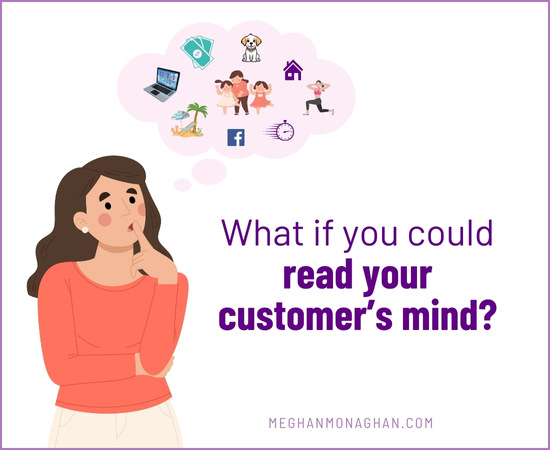
Why? Because knowing that Sharon from Accounting loves her pumpkin spice latte with oat milk gives you the cheat codes to connect on a level that’s more soulmate than salesy. And, when you start speaking your audience’s love language, you’ll not only unlock their hearts but also their wallets.
This isn’t your run-of-the-mill “know your audience” spiel. This is about becoming an audience whisperer.
By the end of this article, you’ll know how to create a buyer persona so laser-focused, it’s like you’ve got your audience’s DNA under a microscope. Armed with this information, you can tailor your content to address prospects’ needs and capture their attention.
And, you’ll have an easier go of coming up with a content strategy that’s in tune with the real people who are your customers.
Buckle up and let’s go!
What is a Buyer Persona?
A buyer persona (or customer persona) in content marketing is a detailed, fictional representation of an ideal customer that helps businesses understand their target audience at a deeper level to tailor their content and marketing strategies to meet the needs and preferences of their customers, resulting in more effective, profitable content marketing efforts.
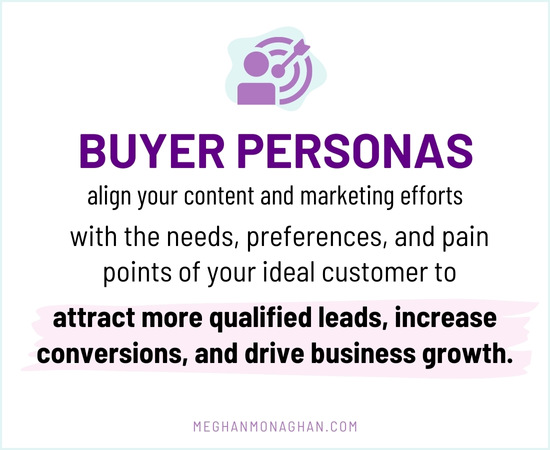
The purpose of a buyer persona is to align content and marketing efforts with the needs, preferences, and pain points of the ideal customer. By understanding the demographic, psychographic, and behavioral traits of the target customer, you can create more relevant and engaging content that resonates with your audience. Ultimately, you will attract more qualified leads, increase conversions, and drive business growth. Jackpot!
An ideal buyer persona helps marketing teams craft targeted content and marketing campaigns. Your blog posts, videos, podcasts, social media posts, and emails will be far more effective!
And here’s a bonus for ‘ya: a buyer persona can assist product development by providing insights into what potential customers are looking for.
Why is a Buyer Persona the GPS to Content Marketing Nirvana?
When you’re setting out on an epic cross-country road trip, you plan first. You want a GPS telling you the quickest routes, the scenic overlooks, and where to avoid rush-hour gridlock.
In content marketing, your buyer persona is that indispensable GPS, guiding you through the route to avoid potential roadblocks and making sure you don’t waste time on the wrong roads.
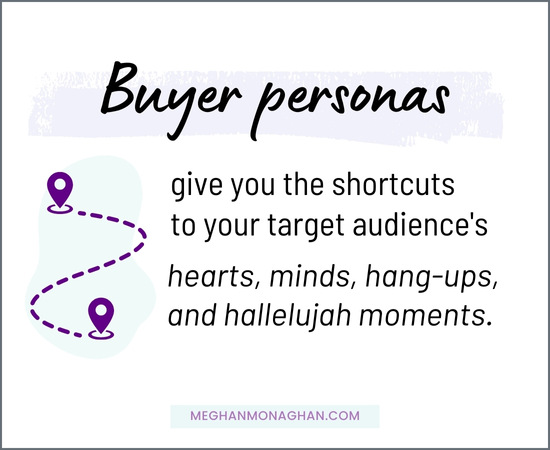
It’s about knowing the exact shortcuts to your audience’s hearts and minds. It’s about understanding their hang-ups and their hallelujah moments.
Armed with this road map, you will get the lay of the land on a micro-level. From what makes your audience tick to what ticks them off, you’ll know it all. And this kind of intel transforms your content from a tiresome journey into a desirable adventure, one that ends with the sweet arrival at Conversion City.
Here are some stats from Marketing Insider Group:
- Companies who exceed lead and revenue goals are 4x as likely to use buyer personas than those who missed lead and revenue goals.
- 56% of companies have generated higher quality leads using buyer personas.
- 36% of companies have created shorted sales cycles using buyer personas.
- 93% of companies who exceed lead and revenue goals segment their database by buyer persona.
Here are some of the reasons why you’d want to use buyer personas to improve your content marketing.
1) Enhanced Targeting and Segmentation
Buyer personas enable you to segment your audience based on different characteristics, such as demographics, interests, or behavior. This segmentation allows you to deliver highly targeted content that speaks directly to each segment, which increases the chances of converting leads into customers.
Why? Just like a juicy rare hamburger at a vegan convention would miss the mark, the wrong marketing messages to your prospects fall flat and have zero effect.
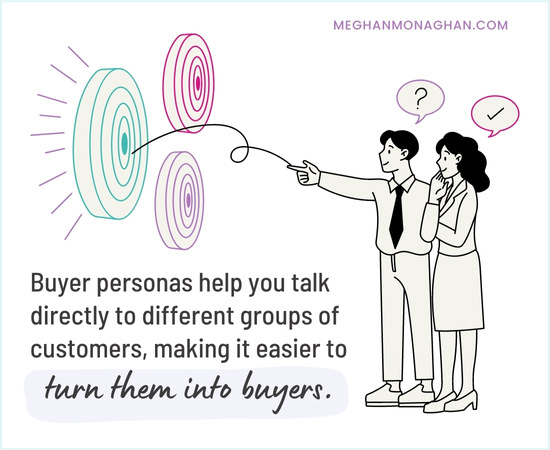
These days, consumers expect more personalized experiences. An outdated “one-size-fits-all” marketing approach doesn’t work as well as it once did.
Segmenting your audience means that you identify distinct groups of potential customers with shared characteristics. These characteristics can include demographics such as age, gender, location, and education level, as well as psychographic factors like interests, values, and behaviors. Then you can create content that appeals to each segment, which makes your marketing more effective and profitable.
That’s why a buyer persona helps to create a content strategy tailor-made to delight each segment of your audience, from the casually curious to the ready-to-buy.
2) Improved Messaging
By thoroughly understanding the needs, pain points, and communication preferences of your target audience, you can better tailor your marketing messages to be more relatable.
You’ll understand your ideal prospective customers’ interests, concerns, and aspirations. And, you know the language and terms they use when discussing their needs or challenges in relation to what you offer.
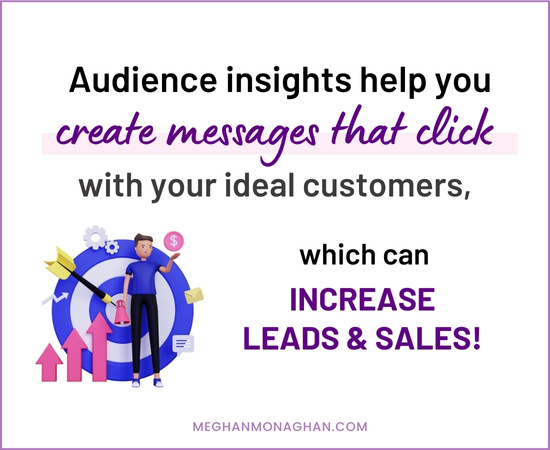
Your persona is a cheat sheet to the soul of your audience. It teaches you the dialects of their desires, the lingo of their pain points, and the buzzwords that light up their eyes.
For example, in the case of Sally, a wannabe eco-warrior, you’ll know to go beyond “eco-friendly” and “sustainability” to tap into her deepest convictions about saving the planet. This will help you to articulate that passion and speak her language in your content. Sally will transform from a passive listener into an avid fan!
That’s the gold you’re digging for: an emotional chord so perfectly struck that your audience can’t help but engage, buy, and eventually advocate for your brand.
By tapping into these insights, it becomes easier to develop targeted messaging that speaks directly to your ideal prospect, builds connections, and improves conversions.
3) Higher Quality Leads
If you’ve been wading through a sea of lukewarm leads, get ready for a change! Creating a buyer persona is one of the best ways to attract more qualified leads—aka people who are primed and closer to making a purchase.
Since you know what makes your ideal customer tick, you’ve got actionable intelligence to help you create content that’s less like a billboard and more like a personal invitation. The result? An audience more aligned with your offers that sees genuine, desirable value in your products or services.
Plus, no more educated guesses on where to find these high-caliber leads; you’re executing a finely-tuned strategy since you know where they hang out online and what kind of content they devour.
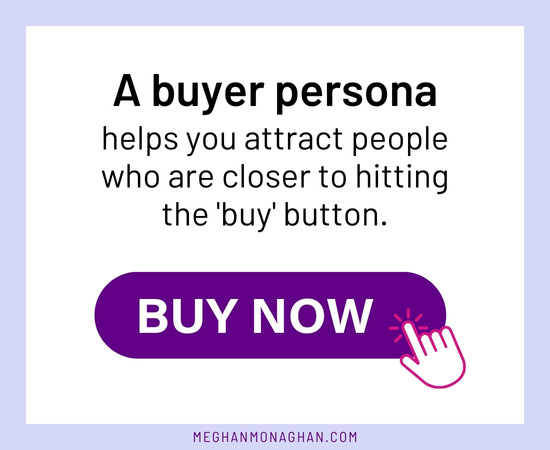
Not only will you get higher quality leads but also you’ll know how to allocate resources more wisely. This translates to a lower cost-per-acquisition and a smarter use of your marketing budget.
And let’s talk conversions—because isn’t that the ultimate goal? When you tailor your marketing to mirror the preferences of a very specific audience, you’re not just casting a wide net and hoping for the best. You’re targeting those who are not just likely but eager to bite.
That’s the advantage of quality over quantity: it’s less work to turn leads into customers. You focus on the low-hanging fruit rather than the hard-to-reach coconuts, which boosts your conversion rates and grows your business.
In a nutshell, buyer personas elevate the entire lead generation process. They enhance targeting, make your resource allocation more efficient, and most importantly, attract leads that are genuinely interested in what you offer.
4) Better Support for the Customer Journey
Remember how I mentioned that a buyer persona is a trusty GPS to guide your content marketing? Well, think of it as a co-pilot to help you create content for the three milestones of your customer’s decision-making journey (otherwise known as the “marketing/sales funnel”):
- Top of the Funnel (TOFU)
- Middle of the Funnel (MOFU) and
- Bottom of the Funnel (BOFU).
At each stage, prospects need different information that addresses their various objections, questions, and fears.
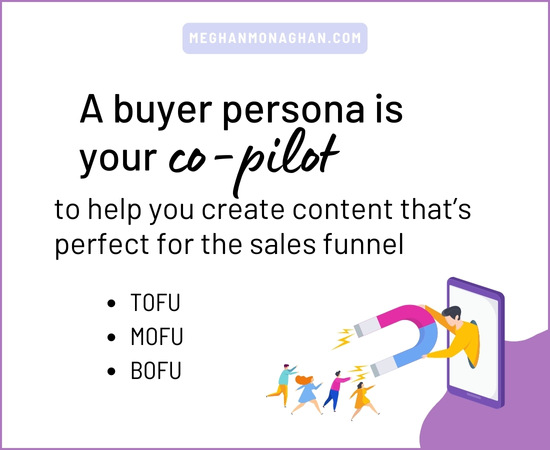
So, equipped with a buyer persona, you know what content to publish for each stage in the funnel since you understand the decision making process as well as what’s inside of your prospect’s head and heart.
The end result? A smoother, more engaging path to conversion, built on a foundation of real, data-driven understanding of your audience’s needs and desires.
5) Ability to Unlock the Heartstrings that Pull the Purse Strings
Ever wondered why some content strikes a nerve while others barely skim the surface? It’s not just about meeting needs or solving problems; it’s about igniting emotions that push people to hit that “Buy Now” button. And, that’s another key advantage of creating a buyer persona: the ability to focus on the emotions that influence purchase decisions.
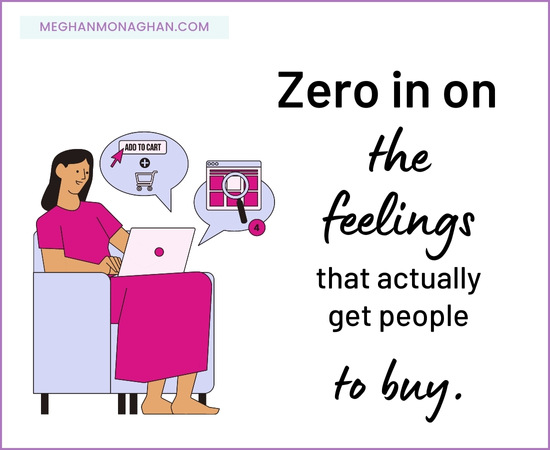
A customer persona helps to investigate not just what your audience wants, but what they feel. Whether it’s a craving for quality that makes them comfortable splurging or a thirst for value that sends them bargain-hunting, these emotional triggers are gold for your content strategy.
For instance, let’s say a segment of your audience places a premium on quality. You’re not just going to tell them your product is top-notch—you’re going to evoke the deep-seated emotions that make them yearn for the best. Your content should reverberate with words like “craftsmanship,” “excellence,” or “luxury,” making it clear that your higher price is not a cost, but an investment in unparalleled quality.
On the flip side, if your customer research reveals an audience segment that’s powered by the pursuit of a good deal, you shift gears. Your content concentrates on “value,” “efficiency,” and “savings,” dialing into the emotions that make them feel smart and savvy for choosing you.
Tapping into emotions isn’t just a tactic; it’s an art form. And, it’s not easy or everyone would be good at it!
By leveraging buyer personas, you’re striking an emotional chord and opening up a deeper level of engagement, which turns interest into action.
6) Improved Content Relevance
You know that feeling when you stumble on a webpage only to be greeted by content that’s utterly irrelevant to you? You make a judgment call in a few seconds and you’re outta there!
Buyer personas help you avoid content and messaging that isn’t relatable. Instead, people will think, “Wow, it’s like they read my mind!” That personal touch makes a difference in keeping people around and turning them into leads.
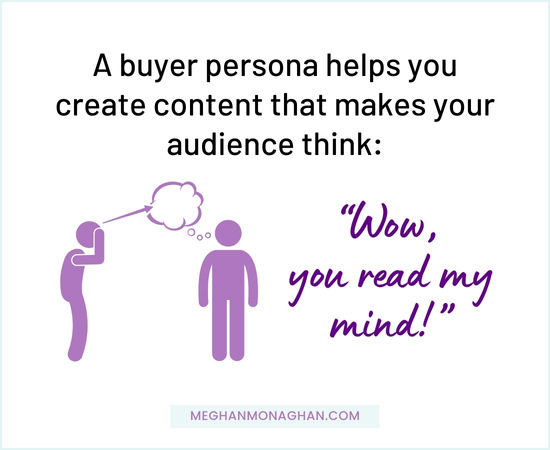
Let’s pretend that your customer research uncovers that a segment of your audience is drowning in their to-do lists. Bingo! That’s your cue to publish custom content centered on productivity hacks, time-management tools, or even work-life balance.
You’re not just solving problems; you’re answering prayers, which turns your brand into a lifeline for customers rather than just another business.
Furthermore, knowing your audience’s preferences for content delivery equates to wrapping your message in the most irresistible package. If your potential customer loves the eye-catching infographics or gets hooked by punchy videos, give them that visual feast. You’ll be tuning into their wavelength, making your message not just heard, but felt.
The beauty of tailoring content this way? Effective messaging with less trial and error. Each word, image, and video is intentionally created to click with your people.
The outcome is worth it! Content that grips attention, stokes engagement, and most importantly, turns visitors into leads. How would it feel if each content piece was a direct hit? Delicious!
7) Better Return On Investment (ROI) For You
ROI isn’t just a buzzword; it’s the yardstick by which your efforts are measured. But creating a buyer persona can upgrade your content marketing and make it more cost-effective.
First off, let’s talk numbers—views and clicks, to be precise. When your content solves real problems or satisfies the true desires for your target audience, guess what happens? They don’t just skim and bounce; they engage. They click and consume.
That’s more eyeballs on your content and more clicks that lead to conversions, positively impacting your bottom line in a big way.
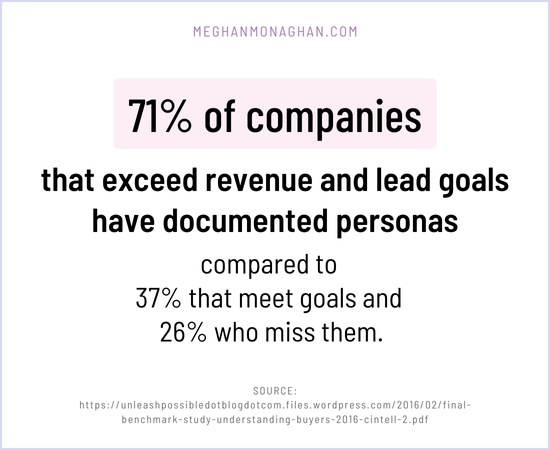
Let’s not forget the “brand loyalty” factor. When people stumble upon content that feels like it’s written just for them, they don’t just consume it; they cherish it. They become your brand advocates—your social media sharers, your word-of-mouth marketers. These loyal followers don’t just boost your follower count; they amplify your message, making your marketing dollars stretch even further.
Speaking of dollars, what about efficiency? Knowing your audience like the back of your hand means you won’t be guessing and hoping. You’ll know exactly where to invest your resources, from the kind of content you should be producing to the platforms where you should be promoting it.
Overall, you get more bang for every marketing buck you spend.
8) Easier Content Strategy and Creation
Crafting an effective content marketing strategy isn’t just about churning out content; it’s about producing the right content for the right audience at the right time. This can be really tough to do!
However, by creating a buyer persona and knowing exactly who your target audience is, you can more easily fine-tune your content to increase both engagement and conversions. It makes your job as a content marketer less stressful and overwhelming.
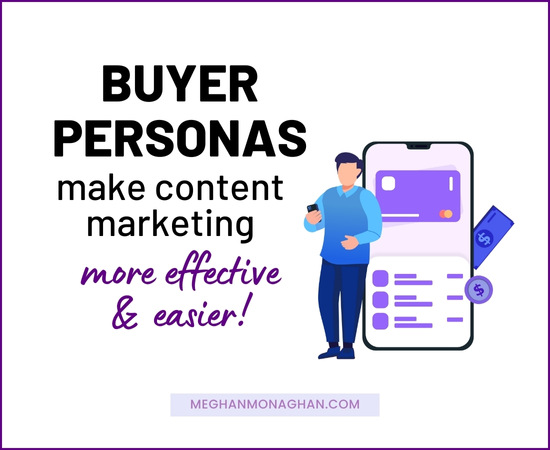
The buyer persona guides tone, style, and forms of communication. You’ll know what to say AND how to say it. You’ll be informed about whether a casual, friendly tone or a more formal, authoritative one will resonate more with your target audience.
Plus, you’ll gain insights into where your audience hangs out online, enabling you to focus your content and promotional efforts more effectively (which is better for the budget!).
Integrating buyer personas into your content marketing doesn’t just make life easier; it makes your strategy smarter and your content more compelling. By aligning your content with both business goals and the stages of the buying cycle, you’re accomplishing what so many marketers struggle with: effective, profitable content!
How to Create a Buyer Persona (and Make Your Content Marketing Better and Easier in the Process)
Creating a buyer persona involves a step-by-step process that requires research, data analysis, and thoughtful consideration. Here’s a breakdown of the key steps involved:
Step 1: Conduct Comprehensive Audience Research
Ready to play detective? To create a buyer persona, you first need to gather as much information as you can about your target audience!
Look into their demographics like age, gender, geographical location, education, and income. Find out their psychographics, such as interests, values, behavior, or even the common problems they face. This insight will help you create content that resonates emotionally, making your brand a go-to source for information and solutions.

This information forms the foundation of your buyer personas, allowing you to create content that directly addresses their needs and interests. Ultimately, understanding customer challenges is pivotal. If you know what keeps your prospects up at night, you can tailor your content to address those specific needs, thereby positioning you as an authoritative expert who is a reliable helper.
Lastly, don’t forget to analyze their buying behavior. What motivates them to take out their wallets? Recognizing these triggers will allow you to develop content that not only informs but also encourages action.
In short, audience research is the cornerstone of building a buyer persona, setting the stage for content that genuinely speaks to your prospective customer.
There are many, many ways to research your target audience. Let’s talk about some of them.
Analyze Existing Prospect and Customer Data
Start by scrutinizing the data you already have on your existing customers. This includes demographics, buying patterns, and interactions with your brand. Current customers can offer clues about what future prospects might find appealing.
Next, delve into the analytics of your digital platforms. Evaluate website metrics, social media engagement, and email performance to uncover what content or features draw your audience in.
Tools like Facebook Audience Insights can help you gain a deeper understanding of your audience’s Facebook activity, including their interests and behaviors, to refine your buyer personas even further.
Ask! Interview and Survey Customers
For more direct insights, engage your target audience through interviews and surveys. This will help you grasp not just what motivates them to buy your product but also the challenges they encounter and what influences their purchasing choices.
Customers, email list subscribers, and community members may not always know what motivates them or even how they really feel. However, it’s always worth asking! Firsthand insight into the minds and emotions of your engaged audience is important research for creating a buyer persona.
Customer interviews offer an opportunity for candid, open-ended conversations that can delve into the customer’s experiences, aspirations, and concerns.
On the other hand, surveys—featuring both multiple-choice and open-ended questions—provide a broader scope of responses. The anonymity of surveys often encourages more honest feedback that you may not receive during an interview.
Interviews and surveys can help you to understand your customers’ motivations for purchasing your product or service, the challenges they face, and the factors that influence their buying decisions. So, consider this one of the best ways to collect research for creating a buyer persona.
Examine Industry Reports and Secondary Market Research
Now it’s time to look outside your customers and prospects to get a wider view of the market.
Industry-specific associations, research firms, and other companies in your niche can be a wealth of data. These sources provide a broader perspective into market trends, customer preferences, and general demographic trends and psychographic profiles.
Overall, industry data can help you identify common characteristics, behaviors, and preferences to help create a buyer persona.
Pay Attention to Reviews
The good, the bad, the ugly—it’s all intel for sprucing up your buyer persona and shaping a content strategy that hits home.
Customer reviews shed light on both positive and negative feedback from your target audience. These can be reviews for your offers or for others’ products and services that are similar to or related to your offers.
By reading through reviews, you can identify demographics and psychographics as well as issues or challenges that customers face. Reviews also indicate content preferences and what type of content resonates with your target audience. These things can help you to create a buyer persona and guide your content creation strategy, ensuring that you produce content that aligns with their interests and preferences.
Reviews uncover what’s working and what’s not–with your offers and with the offers of your competitors. So, pay attention to what people are saying! You’ll find opportunities for improvement as well as indications as to what customers want or need.
Analyze the Competition
You don’t need to be a secret agent to spy on your competitors! Check out their blogs, reviews, social media, comments, SEO statistics, and content. Dedicate some time to see what they are publishing, what the engagement is like, and what their audience is saying.
Remember: you’re searching for indications of your target audience’s preferences and desires to guide your own buyer persona and content.
Tools like Semrush, Ubersuggest, and even Google can help you determine the effectiveness of your competition’s content. Take notes so that you can use the competition to inspire and guide your own content direction. Identify gaps in their content strategy and discover opportunities to differentiate your brand.
Talk with Customer Support
If you have a customer support team, talk with them or gather data from their customer interactions to discover more about your audience to create a buyer persona. Whether it’s recurring complaints, FAQs, or general buzz, the customer support team can give you the skinny on what your audience is really asking for.
Review customer support interactions such as emails, live chats, or phone calls. Tap into the frontline experiences and knowledge of your team to discover valuable insights from their direct experiences with customers.
Brainstorm with ChatGPT
Why not use ChatGPT as your brainstorm buddy to help you build a buyer persona?
Of course, ChatGPT isn’t always accurate, but it does have access to data and can analyze it to help you create a customer persona in less time. #winning
**Note: You can also give ChatGPT data to process via the interface or through a plugin.
Here are more specific details on how to use ChatGPT to gain customer insights and create a buyer persona:
2) Analyze Data and Identify Patterns
Data without analysis is like a treasure map with no X marking the spot. It’s time to analyze your research.
What’s not inspected, isn’t respected! – My Dad
Take the research you’ve done, and identify patterns and commonalities in your target audience. Look for shared characteristics, behaviors, and preferences that can help you create buyer personas.
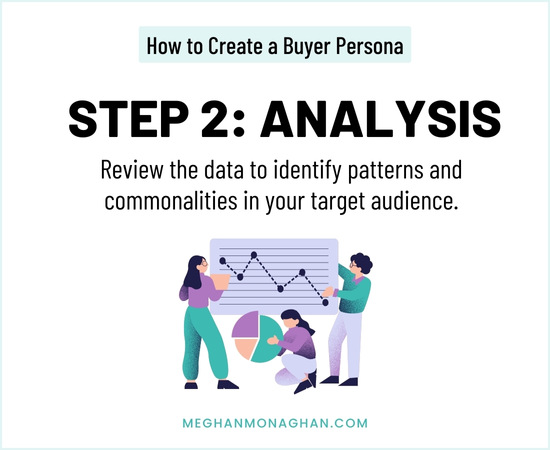
For example, you may find that a significant portion of your audience consists of executives over age 45 who value convenience so they are willing to pay a premium for time-saving solutions. This insight can help you create a buyer persona that specifically targets this segment.
Keep an open mind. You may discover things that go against what you’ve thought about your target audience!
And, you could find different segments or categories within your target audience. This means you may need to create a few different buyer personas to tailor your content marketing efforts even more effectively.
Here are a few patterns and commonalities to look for when you’re analyzing the data:
Speak Their Language (Literally)
Pay attention to the language, terms, and phrases used by customers and prospects. Look for words that frequently appear, such as “time management” or jargon that they use, such as that new shirt is “fire.”
Language patterns give you a glimpse into their mindset, but it’s also your secret sauce to relatability. Sprinkle their lingo throughout your content, and voila, you’ve got instant rapport!
You’ll also come across as more knowledgeable and relevant. They will believe that you understand them, which makes your brand more believable as something or someone that can help them.
Word of warning, though! Overcomplicating your language just to flex your industry know-how can backfire. Make sure you’re not alienating your ideal customers by speaking over their heads—or underestimating them, for that matter.
When in doubt, opt for simple and straightforward over complex and overwhelming. Carefully select words that align with their values and needs. By speaking their language, you can establish a connection and build trust through your content.
Identify Your Customer’s Kryptonite
When analyzing the research you did, be on the lookout for common struggles and problems your target audience faces. Understanding the problem you solve for your customer is super important! So, if you haven’t been able to wrap your head around why people hire you, this is your chance!
Also, consider who they typically turn to when they have problems (friends, family, professionals, YouTube or Instagram influencers?) and how they prefer their challenges be solved (quick fix or long-term?).
Knowing their preferred approach to making purchase decisions can guide your content creation so that it aligns with their expectations.
Content Cravings and Platform Picks
Look for patterns in content consumption. What’s their platform of choice? What types of content do they prefer?
Some folks might be all about those entertaining or instructional “how to” YouTube videos. Others may prefer coffee over in-depth Medium articles. Then there are those prospects who love to listen to podcasts while they exercise or run errands.
The point is to find out their content preferences. This is critical intel for tailoring your content to their liking and hanging out where they hang out.
Their preferred platforms and content types help with both content creation and distribution so that you generate maximum engagement and distribute your content effectively.
By delivering content in the formats and on the platforms they prefer, you increase the chances of capturing their attention, building trust, and ultimately driving them towards your products or services.
3) Create a Buyer Persona Using a Template
Okay, you’re finally ready to put all of the information together to create a buyer persona, yippee!
However, there’s no need to start from scratch. Download or use a buyer persona template to help summarize the findings from your research and analysis in one location. (Some template suggestions are below.)
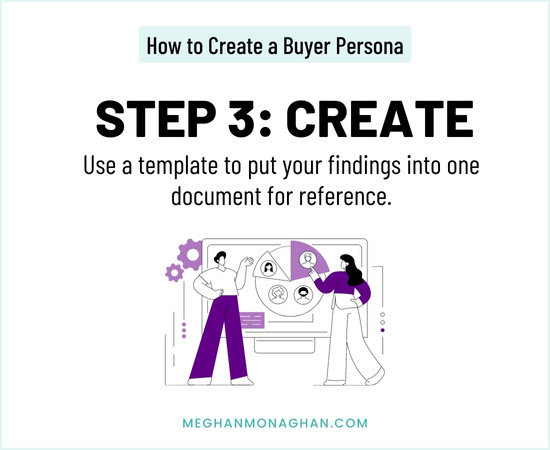
A buyer persona template organizes the information you’ve gathered to craft a detailed profile of your ideal customer.
Your buyer persona template should include sections such as demographics, psychographics, background, goals, challenges, preferred content and communication channels and platforms, and any other relevant details to craft a comprehensive and realistic representation of your target audience.
After you have the template, fill it in with the relevant information from your research. Give your buyer persona a name, a profile picture, and even a fictional backstory if it helps you to visualize them for more effective marketing. It’s easier to market to a person than a nameless, faceless non-entity, right?
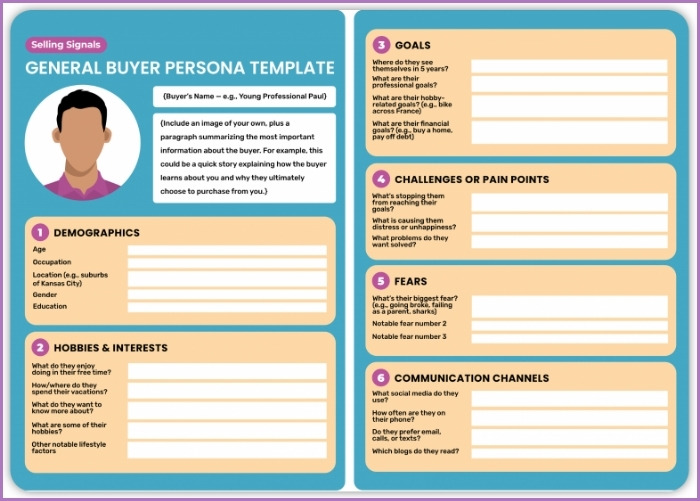
Once the buyer persona is done, share it with your team, including outside consultants or contractors who help you with marketing. This ensures everyone aligns their efforts based on the identified target audience and make your content marketing strategy more effective.
By the way, once you really know who you’re talking to, content creation becomes a lot easier!
Buyer Persona Templates
- Semrush’s Persona online tool
- Hubspot’s Make My Persona online tool
- Hubspot’s downloadable templates
- Creately
- Venngage
B2B Vs. B2C Buyer Personas
You may be wondering, “Does it matter to the buyer persona if my customers are other businesses? Does this buyer persona thing work the same way?”
Those are good questions! The short answer is not exactly.
There are key differences between B2B and B2C buyer personas that content marketers should be aware of.
B2B = When your customer is a business (Business to Business)
B2C = When your customer is an individual person (Business to Consumer)
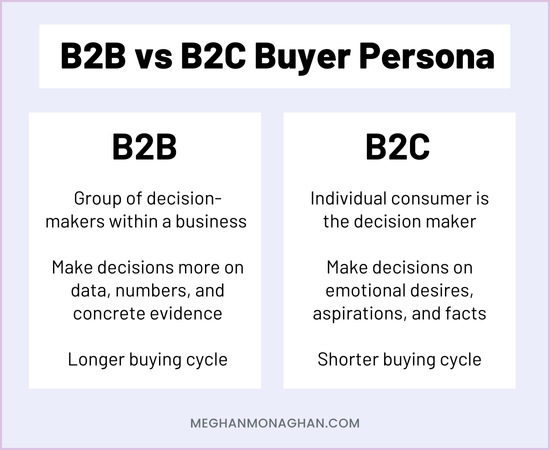
In the B2B world, things usually move at a slower pace. You’re not just convincing one person to click “buy.” Usually, you’re trying to sway more than one person, an entire team, or even a board of decision-makers. Purchases may have to go through an approval process.
Therefore, B2B buyer personas need to take into account multiple stakeholders, their roles, and the specific pain points they are trying to address. Whereas certain individuals control the purchase decision, the pain points are organizationally driven. It’s a bit more challenging!
So, content should focus on more logical stuff like ROI (Return on Investment) and case studies and less about individual needs and concerns.
When you’re in the B2C zone, things are more straightforward. You’re talking directly to the decision-maker and the person who will use what you’re selling. They’re generally quicker to decide, driven more by what they want or need right now.
Thus, B2C buyer personas should include demographics, psychographics, and preferences related to their emotional desires and aspirations. And, content for B2C buyer personas is more focused on the individual and can tug at the heartstrings to evoke positive emotions and create a desire for the product or service.
The Takeaway
The essence of it all? B2B buyer personas should focus on meeting the needs of a group of decision-makers within a business. They want data, numbers, and concrete evidence that what you’re offering will solve their problems. B2C personas, on the other hand, should target individuals and aim to connect on a personal, emotional level.
By understanding these differences, you’ll be better equipped to tailor your content marketing efforts to the right audience. Whether you’re selling to businesses or individual folks, knowing what motivates them is the key to making your messages hit home.
How Buyer Personas Guide Content Strategy and Creation
With your buyer personas in hand, it’s now time to put them to work and use them to guide your strategy and content. After all, personas are basically cheat sheets for what is important to your potential customers both practically and psychologically.
When it comes to content strategy, step 1 – your “who” – is checked off the list! Now, use the persona to sort out the “what.” Let the persona and your business goals determine what content you need to create and for which platforms.
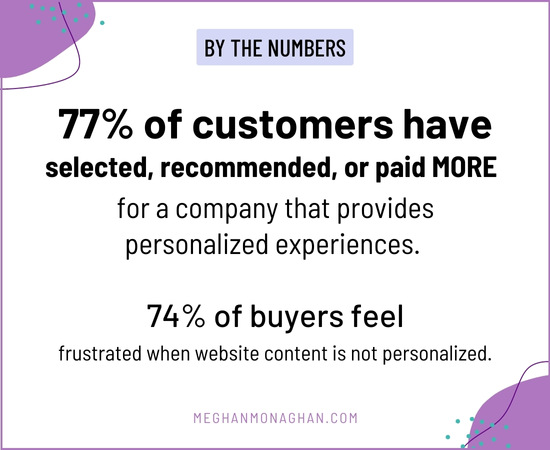
Next, use your content strategy and buyer persona to guide your content creation. You should be able to choose content topics more easily. Plus, you understand what needs to be addressed and how within each piece of content.
Having a solid buyer persona makes everyone’s job easier, from your writers to your social media team since you’re all on the same page. When it comes to your content marketing, you and your team know who you’re talking to and what they care about. So, in the grand scheme of things, the persona accomplishes more than just better marketing. It also makes implementing content marketing easier and faster with more consistent messaging.
Buyer Personas are Your Guide to Content Marketing Success
If you’ve felt like you’re just shouting into the online void with your content, a good buyer persona is a game-changer. It’s like having a playbook for what your audience loves, needs, and really, truly cares about. This isn’t just about making your content pop. It’s about making content that feels like it was tailor-made for each person consuming it.
Let’s be real: the internet is jam-packed with content! If you want to stand out, you’ve got to connect on a human level. That’s where your buyer persona comes in. It helps you get personal and strike an emotional chord that many businesses just aren’t doing these days.
But here’s the catch…this exercise isn’t a “set it and forget it” one. As your business evolves and your audience changes, always refine and update your buyer personas.
So, as we zoom toward 2024, here’s the takeaway: align what you offer with what your customers want. That’s how you turn one-time visitors into leads and customers. Put in the time to craft accurate buyer personas to elevate your content and grow your business over the long term.

Soooo much content and goodness in this… and when I first started to read it my thoughts were – so many things people don't understand… like target marketing, no, not everyone who "needs" your services is going to use them and speaking their language (hence persona) surely does help drive the conversion.
The next thought is it reminds me of niche marketing, like the shooting community, they know something is up or someone is behind the wheel that shouldn't be when you use terms the community doesn't use.
So this and everything you are giving out, for free, so valuable. Thank you for all of this!
Excellent point K10! People gather a lot of information from the language, words, and phrases we use. That’s why copywriters get paid the big bucks, right? LOL I’ve struggled with understanding my target audience…sure, it’s nice to know that I help small business owners, but that market is far too broad and general. Once we understand who we help, it can make marketing so much easier! That’s why I’ve been focusing on this a little more. I appreciate your comment, thank you for supporting me!